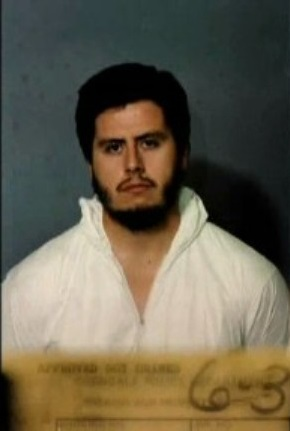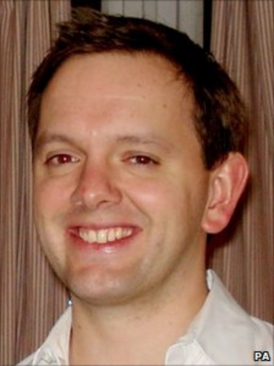
Bank robbery is the criminal act of stealing from a bank, specifically while bank employees and customers are subjected to force, violence, or a threat of violence. This refers to robbery of a bank branch or teller, as opposed to other bank-owned property, such as a train, armored car, or (historically) stagecoach. It is a federal crime in the United States.
The Flying Squad is a branch of the Serious and Organised Crime Command within London's Metropolitan Police Service. It is also known as the Robbery Squad, Specialist Crime Directorate 7, SC&O7 and SO7. It is nicknamed The Sweeney, an abbreviation of the Cockney rhyming slang "Sweeney Todd".
Henry Bruce Stanley was a Scottish painter and decorator who was shot dead by the Metropolitan Police in London in contentious circumstances. Initially his death was recorded with an open verdict, before being ruled as unlawful killing by a jury on appeal and finally returned to an open verdict by the High Court.

The Specialist Firearms Command (MO19) is the firearms unit of the Metropolitan Police Service. Formed in 2005, the Command is responsible for providing a firearms-response capability, assisting the rest of the service, which is not routinely armed.
The Walsh Street police shootings were the 1988 murders of two Victoria Police officers: Constables Steven Tynan, 22, and Damian Eyre, 20.
The Brixton riot of 1985 started on 28 September in Lambeth in South London. It was the second major riot that the area had witnessed in the space of four years, the last in 1981. It was sparked by the shooting of Dorothy "Cherry" Groce by the Metropolitan Police, while they sought her 21-year-old son Michael Groce in relation to a robbery and suspected firearms offence; they believed Michael Groce was hiding in his mother's home.

The North Hollywood shootout, also known as the Battle of North Hollywood, was a confrontation between two heavily armed and armored bank robbers, Larry Phillips Jr. and Emil Mătăsăreanu, and police officers in the North Hollywood neighborhood of Los Angeles on February 28, 1997. Both robbers were killed, twelve police officers and eight civilians were injured, and numerous vehicles and other property were damaged or destroyed by the nearly 2,000 rounds of ammunition fired by the robbers and police.

A shootout, also called a firefight, gunfight, or gun battle, is an armed confrontation entailing firearms between armed parties using guns, always entailing one or more intense disagreements between the involved parties. The term can be used to describe any such fight, though it is typically used in a non-military context or to describe combat situations primarily using firearms.

James Ashley was a British man who, while unarmed and naked, was shot dead by police in his flat in St Leonards-on-Sea, East Sussex, on 15 January 1998. Armed officers raided the building on the suspicion that Ashley kept a firearm and a quantity of cocaine there, and to arrest him and another man in connection with a stabbing. Neither a firearm nor a significant quantity of drugs was found, the other man was not present, and it later emerged that Ashley was not implicated in the stabbing. Ashley, likely woken by the noise of the raid, was out of bed when an armed police officer entered his bedroom. On seeing the officer, Ashley raised one arm and the officer reacted by firing a single shot. Later that morning, Sussex Police chief constable Paul Whitehouse held a press conference in which he praised the conduct of the operation.
Stephen Waldorf was shot and seriously injured by police officers in London on 14 January 1983 after they mistook him for David Martin, an escaped criminal. The shooting caused a public outcry and led to a series of reforms to the training and authorisation of armed police officers in the United Kingdom. Martin was a thief and fraudster who was known to carry firearms and had previously shot a police officer. He escaped from custody in December 1982, and the police placed his girlfriend under surveillance. On the day of the shooting, they followed her as she travelled in a car whose front-seat passenger (Waldorf) resembled Martin. When the car stopped in traffic, Detective Constable Finch—the only officer present who had met Martin—was sent forward on foot to confirm the passenger's identity.

The Emergency Response Unit (ERU) is the police tactical unit of the Garda Síochána, Ireland's national police and security service. The unit was a section of the forces' Special Detective Unit (SDU), under the Crime and Security Branch (CSB) until 2017, when the Special Tactics and Operational Command was created to take over its operational duties alongside Armed Support Units.

On 5 April 2004, at 8 AM the Nokas Cash Handling in Stavanger, Norway was raided by heavily armed men. It was the biggest-ever heist in Norway.
Derek Creighton "Bertie" Smalls was considered by many as Britain's first supergrass. Although there have been informers throughout history – the Kray twins were partly convicted two years before Smalls on evidence given by Leslie Payne – the Smalls case was significant for three reasons: the first informer to give the police volume names of his associates and provide the evidence that would send dozens of them to prison to serve long sentences; the first criminal informer to strike a written deal with the Director of Public Prosecutions; the only criminal informer to serve no time for his crime in return for providing Queen's evidence.

Jean Charles da Silva e de Menezes was a Brazilian man killed by officers of the Metropolitan Police Service at Stockwell station on the London Underground after he was wrongly deemed to be one of the fugitives involved in the previous day's failed bombing attempts. These events took place two weeks after the London bombings of 7 July 2005, in which 52 people were killed.

The Millennium Dome raid was an attempted robbery of the Millennium Dome's diamond exhibition in Greenwich, South East London occurring on 7 November 2000. A local gang planned to ram-raid the De Beers diamond exhibition, which was held in the riverside Dome. The gang had then planned to escape via the Thames in a speedboat.

The Father's Day Bank Massacre was a bank robbery and shooting that took place on Sunday, June 16, 1991, at the United Bank Tower in Denver, Colorado, United States. The perpetrator killed four unarmed bank guards and held up six tellers in the bank's cash vault. An estimated $200,000 was stolen from the bank. Nearly three weeks later, on July 4, 1991, authorities arrested retired police officer James W. King for the crime. The subsequent trial was broadcast nationally on Court TV. After days of deliberation, the jury acquitted King. None of the stolen money was ever found. The crime remains unsolved and is considered a cold case.

The 2010 Northumbria Police manhunt was a major police operation conducted across Tyne and Wear and Northumberland with the objective of apprehending fugitive Raoul Moat. After killing one person and wounding two others in a two-day shooting spree in July 2010, the 37-year-old ex-prisoner went on the run for nearly a week. The manhunt concluded when Moat died by suicide having shot himself near the town of Rothbury, Northumberland, following a six-hour standoff with armed police officers under the command of the Northumbria Police.

Mark Duggan, a 29-year-old black British man, was shot dead by police in Tottenham, North London on 4 August 2011. The Metropolitan Police stated that officers were attempting to arrest Duggan on suspicion of planning an attack and that he was in possession of a handgun. Duggan died from a gunshot wound to the chest. The circumstances of Duggan's death resulted in public protests in Tottenham, which led to conflict with police and escalated into riots across London and other English cities.

Mark Saunders was a British barrister who was shot dead by police on 6 May 2008 after a five-hour siege at his home in Markham Square in Chelsea, London. Saunders was a successful divorce lawyer who struggled with depression and alcoholism. He had been behaving erratically and drinking heavily in the hours before the incident. Neighbours called the police after Saunders repeatedly fired a shotgun from a window shortly before 17:00. When armed police officers arrived, Saunders fired at their vehicle and the siege began. More armed officers arrived and took up positions in surrounding buildings and on the street. Saunders fired on two more occasions and the police returned fire, slightly wounding him. Around 20 minutes after the previous round of shooting, just after 21:30, Saunders waved the shotgun out of a window. As he lowered it in the direction of a group of police officers, seven officers fired eleven shots, of which at least five struck him. Police entered his flat minutes later and Saunders was taken to a waiting ambulance where he was pronounced dead.
Jermaine Baker was shot dead by a Metropolitan Police officer in Wood Green, London on 11 December 2015. Baker, who was unarmed, was shot during a police operation to prevent a suspected plot to free two prisoners being transported to Wood Green Crown Court. Baker's death led to an investigation by the Independent Police Complaints Commission, which was continued by its successor body the Independent Office for Police Conduct, and a criminal investigation which did not result in criminal charges being brought against the officer who shot Baker. A public inquiry into Baker's death launched in June 2021 and reported in July 2022, finding that the police operation in which Baker was killed had involved a series of failings, but that Baker's killing was nonetheless lawful.















